Introduction
New institutions are often faced with the problem of selecting the accounting standard to use. If an institution decides to use the International Financial Reporting Standards (IFRS), it faces a challenge of deciding on a suitable accounting policy to adopt. Apart the challenges faced by a new company, existing companies that already use the IFRS also face a number of challenges (International Financial Reporting Standards 2012). For instance, they have to decide on the appropriate policy to use when they want to alter how they report various items in the financial statements. The paper seeks to carry out an evaluation of the various accounting policies in instances where there are a number of policies that an entity selects from a given standard. Further, the paper will carry out a research a sample of fifteen listed companies to examine the accounting policies that they use (Perera & Doupnik 2012).
Accounting policies that entities can choose from in the standards
Subsequent measurement of property, plant and equipment (IAS 16)
- Measurement of property, plant and equipment
The Standard gives management the discretion to choose either the cost model or the revaluation model. Further, the Standard requires that same accounting usage should be applied to the same class of property plant and equipment. The cost model necessitates that at first, an asset should be entered in the books of accounts of the company at the purchase price. However, in succeeding years, the purchase price of the assets should be reduced by the total amount of usage of the asset which is often measured using depreciation (Friedrich & Friedrich 2009; EC Staff Consolidated Version 2009). On the other hand, the revaluation model requires that assets should be recognized at a revalued amount less accumulated depreciation in the subsequent years (Friedrich & Friedrich 2009; International Financial Reporting Standards 2012). During a revaluation, an entire class of asset should be revalued. Thus, the revaluation model is often considered to be quite complex and a number of conditions need to be satisfied before a revaluation is carried out (Friedrich & Friedrich 2009). - Depreciation method
The Standard requires a proportionate amount of usage of the asset should be deducted from the cost of the asset because assets loose value over time (Friedrich & Friedrich 2009; International Financial Reporting Standards 2012). The Standard does not outline a specific depreciation method to be used. However, it states that an entity needs to use a methodical approach to assign the amount of depreciation of an asset over its life. It further states that the method applied by a company should mirror the form in which the entity intends to utilize the upcoming financial gains that arise from the asset (International Financial Reporting Standards 2012). Further, the Standard outlines that the method of depreciation being used by an entity should be reviewed on an annual basis. Thus, it can be observed that there is no specific method that companies is obliged to use to depreciate their assets (Friedrich & Friedrich 2009; EC Staff Consolidated Version 2009).
Subsequent measurement of Intangible assets (IAS 38)
The standard gives information on how to estimate the carrying amount of intangible assets and the disclosures to be made about the intangible assets (International Financial Reporting Standards 2012). The Standard allows management to choose either the cost model or the revaluation model in subsequent measurements” (Friedrich & Friedrich 2009). Based on the cost model, the intangible asset will be reported in the books of account at cost after deducting the total amount of the accumulated amortization and other losses that arise from destruction. When using the revaluation model, fair value of the assets should be obtained periodically.
The intangible assets will be recorded in the books of account at the revalued amount less the amount of accrued amortization and other losses that arise from damages (International Financial Reporting Standards 2012; EC Staff Consolidated Version 2009). The prevalent prices in a dynamic market of the assets are used as the fair value. The standard further requires that all intangible assets in the same category should be given the same treatment (International Financial Reporting Standards 2012; Collier 2009).
Subsequent measurement of Investment property (IAS 40)
IAS 40 gives information on the accounting for property that is held by a company for rental and capital gain (Deloitte Global Services Limited 2013a). Properties held for investment by a company initially recognized in the books of account using the cost or the fair value model. The research carried out in this section will show the extent to which companies use the cost and the fair value model (Deloitte Global Services Limited 2013a; International Financial Reporting Standards 2012).
Cost formulas for inventories (IAS 2)
IAS 2 provides information on how companies should account for the common category of inventories. The Standard gives guidelines for estimating the cost of inventories, for recording subsequent expenses as well as for recording the net realizable value (Deloitte Global Services Limited 2013b). Further, the standard gives information on the cost formulas that can be used to allocate costs to inventories.
The Standard outlines that inventories should be estimated at the lower of cost and net realizable value (Deloitte Global Services Limited 2013b). Further, the Standard provides information on the various methods that can be used by a company to determine cost. Specifically, the Standard allows for the use of First In First Out (FIFO) and the weighted average cost formulas (International Financial Reporting Standards 2012). However, the Standard abolished the use of the Last In First Out (LIFO) cost formula since 2003. Thus, it can be observed that entities have the discretion of selecting either of the two cost formulas.
Initial measurement of non-controlling interest (IFRS 3)
IFRS 3 gives provides guideline on the accounting when an acquirer attains control of an entity. This can be though merger, combination or acquisition. Acquisition method of accounting is used to account for such business amalgamation (Deloitte Global Services Limited 2013c). When using this approach, the assets and liabilities acquired by an entity are recognized in the books of account at their fair value. The fair values are computed at the acquisition dates (Deloitte Global Services Limited 2013c). IFRS 3 allows business to use either at fair value or at the non – controlling interest’s proportionate share of the acquirer’s identifiable net assets (Deloitte Global Services Limited 2008; International Financial Reporting Standards 2012).
The form of the income statement (IAS 1)
The Standard gives information gives information on how the financial statements should be structured and the various accounting principles that should be used when preparing the books of account. The Standard outlines that an entity can either present single statement of comprehensive income or two statements (Deloitte Global Services Limited 2013d). The two statements show profit and loss earned by a company and the constituents of the all-inclusive income (Deloitte Global Services Limited 2013d; International Financial Reporting Standards 2012).
Summary of research based on a sample of fifteen companies
The information presented in the table below gives a summary of the information obtained from the research carried out on the accounting policies used by the fifteen different companies.
The information in the table above can be presented in pie charts as shown in the subsequent section.
Subsequent measurement of property, plant and equipment (IAS 16)
Measurement of property, plant and equipment
From the sample of fifteen companies selected, it was observed that 14 makes use of the cost model while 1 company makes use of the revaluation model. The pie chart presented below shows the proportions.
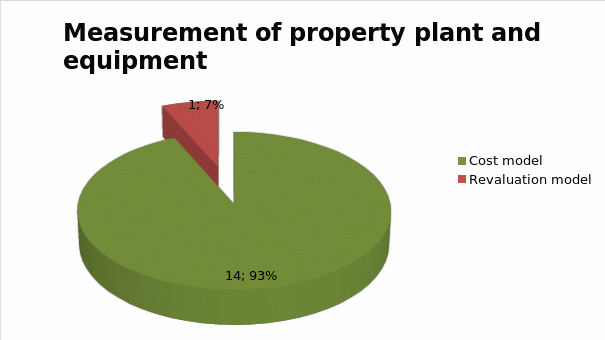
Depreciation method
Based on the sample selected, 12 companies use the straight line method; 1 company uses the unit cost of production method while 2 companies use both methods. The pie chart presented below shows the various proportions.
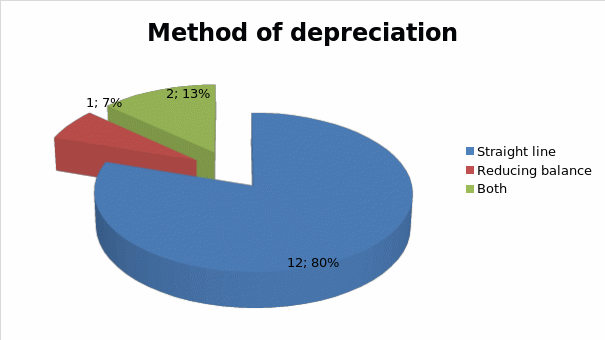
Subsequent measurement of Intangible assets (IAS 38)
From the sample of fifteen companies, 12 companies use the cost method while 3 companies use the revaluation model. The pie chart presented below shows the proportions.
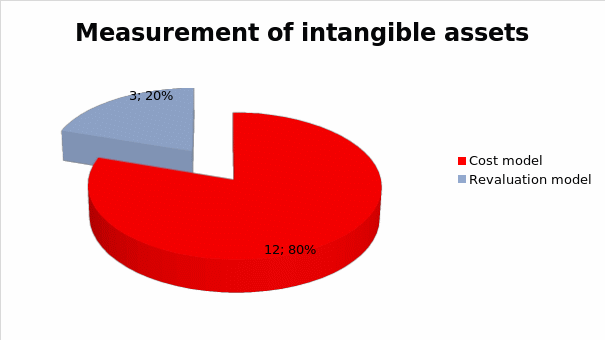
Subsequent measurement of Investment property (IAS 40)
Based on the sample selected, 11 companies use the cost method while 4 companies use the fair value method. The pie chart presented below shows the proportions.
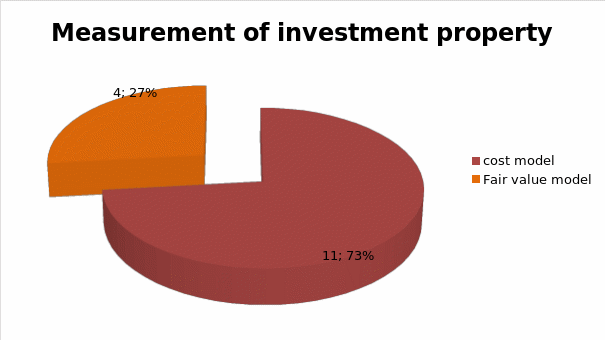
Cost formulas for inventories (IAS 2)
The objective of the research carried out in this section is to show the extent to which companies use the two cost formulas. Based on the sample selected, 4 companies use the FIFO method while 10 companies use the weighted average method. Further, 1 company makes use of both cost formulas. The pie chart presented below shows the various proportions.
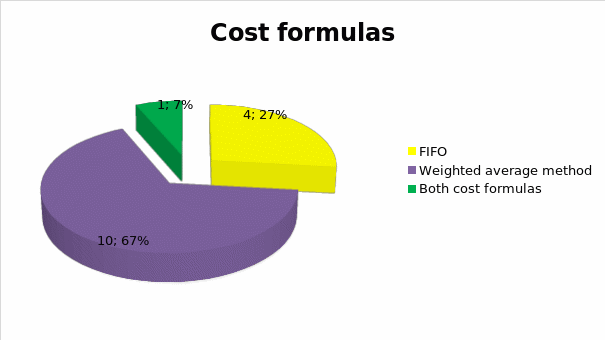
Initial measurement of non-controlling interest (IFRS 3)
The research in this section seeks to find out to what extent the companies selected in the sample makes use of the two approaches. From the sample selected, 1 company used the proportionate share of the non-controlling interest while 15 companies used the fair value approach. The pie chart presented below shows the proportion of the two methods.
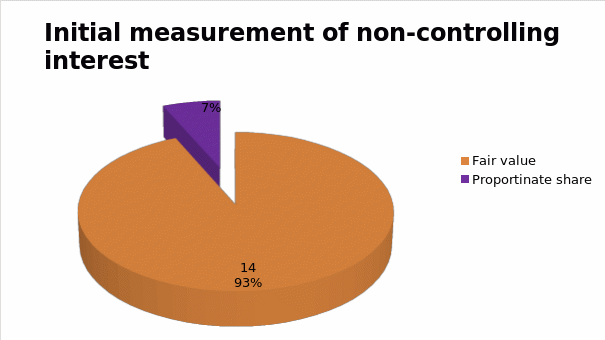
The form of the income statement (IAS 1)
The objective of the research carried out in this section is to show the extent to which companies use the two approaches of presenting the income statement and which method is preferred. Based on the sample selected, it was observed that all the companies use the two income statements form. The pie chart presented below shows the proportions.
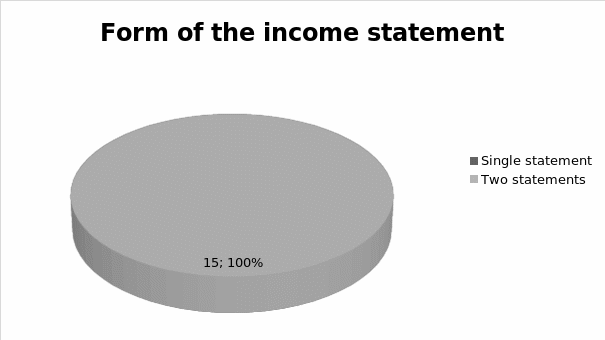
Findings of the research
The results of the research above can be presented in the table as shown below.
Based on IAS 16 on the subsequent measurement of property, plant and equipment , it can be concluded that the revaluation model is less popular across companies in various sectors. 93.33% of the companies use the cost model while only 6.67% company uses the revaluation model. Under the same standard, it can be observed that the straight line model is more popular across companies in various sectors than the other methods. 80% of the companies in the sample use the straight line method, 6.67% use the unit cost of production method while 13.33% use both the straight line and unit cost of production method.
Secondly, based on IAS 38 on the subsequent measurement of intangible assets, it can be observed that most companies prefer the cost model to revaluation model. This can be attributed to the complexities associated with the revaluation model. 80% of the sample uses the cost model while 20% use the revaluation model. Thus, it can be observed that most companies use the cost model. Thirdly, under IAS 40 on the subsequent measurement of investment property, It can be concluded that most companies prefer to measure their investment property using the cost model. The fair value is less preferred since it is often costly to obtain the fair value of property with accuracy on a yearly basis. Based on the statistics above, 73.33% of the sample uses the cost model. Fourthly, research carried out on IAS 2 – cost formulas for inventories shows that the weighted average method is most popular across companies in various sectors since it is simple to use. Also, it can be observed that a significant proportion of companies also use the FIFO method. Some companies also make use of both methods for different products that they trade in.
Further, the research carried out on initial measurement of non-controlling interest (IFRS 3) shows that the fair value model is more popular than the proportionate share of the non-controlling interest approach. It is because when the values of assets and liabilities are often estimated before the business combination takes place. Companies always carry out valuations before merger. This makes it possible to use the fair value model. In scenarios where the businesses have recent valuation reports, then the companies often prefer to use the proportionate share of the non-controlling interest model. Finally, under IAS 1 – the form of the income statement, the single statement form is not used by any company in the sample. All the fifteen companies in the sample used the two statements approach. Thus, the research reveals that the single statement form is not used by companies in practice. This can be attributed to its complexity.
Summary
Based on the research and discussion above, a number of inferences can be drawn. First, based on IAS 16 on the subsequent measurement of property, plant and equipment, it can be observed that most companies prefer to use the cost model for measuring the assets in that category. Further, the majority of companies in the sample used the straight line method of depreciation. Secondly, based on IAS 38 on the subsequent measurement of intangible assets, the research carried out on fifteen companies revealed that most companies used the cost model to measure intangible assets. Thirdly, under IAS 40 on the subsequent measurement of investment property, the research revealed that most companies in the sample used the cost model to measure investment property.
Fourthly, research carried out on IAS 2 – cost formulas for inventories shows that most of the companies used the weighted average cost formula to estimate the cost of inventory. Further, the research carried out on initial measurement of non-controlling interest (IFRS 3) shows that fourteen out of fifteen companies used the fair value model to measure the non – controlling interest. Finally, under IAS 1 – the form of the income statement no company used the single statement of comprehensive income. All the fifteen companies in the sample presented their income statements in two forms.
References
Air Berlin PLC 2012. Annual report 2012. Web.
Arcelormittal Corporation 2012. Annual report 2012. Web.
Bayer AG 2011. Financial statement 2011. Web.
British Petroleum PLC 2013. Annual reporting. Web.
Carrefour Group 2012. Annual reports. Web.
Collier, P 2009. Accounting for managers, John Wiley & Sons Ltd, London.
Deloitte Global Services Limited 2008. Business combinations and changes in ownership interests. Web.
Deloitte Global Services Limited 2013a. IAS 1 – presentation of financial statements. Web.
Deloitte Global Services Limited 2013b. IAS 2 – inventories. Web.
Deloitte Global Services Limited 2013c. IAS 40 – Investment Property. Web.
Deloitte Global Services Limited 2013d. IFRS 3 – business combinations. Web.
EC Staff Consolidated Version 2009. International Accounting Standard 16 (IAS 16), Property, Plant and Equipment. Web.
Fiat Societa Per Azioni 2012. Annual report 2012. Web.
Friedrich, B & Friedrich, L 2009. International Accounting Standard 16 (IAS 16), Property, Plant and Equipment. Web.
GlaxoSmithKline 2012. Annual report 2012. Web.
International Financial Reporting Standards 2012, IAS 38 Intangible assets. Web.
Lufthansa Group 2012. Annual report 2012. Web.
Luxottica Group S.p.A 2012. Annual reports and publications. Web.
Metro Group 2012. Annual report 2012. Web.
Perera, H & Doupnik, T 2012. International accounting, McGraw-Hill, US.
Philips 2012, Annual report 2012. Web.
Prada Milano 2012, Annual report 2012. Web. Prentice Hall Europe, Harlow.
Royal Dutch Shell PLC 2012. Annual report 2012. Web.
Sanofi S.A. 2012. Annual report 2012. Web.
Volkswagen Group 2013, Annual report 2012. Web.
